I am trying to solve for the position of a body orbiting a much more massive body, using the idealization that the much more massive body doesn't move. I am trying to solve for the position in cartesian coordinates using 4th order Runge-Kutta in python.
Here is my code:
dt = .1
t = np.arange(0,10,dt)
vx = np.zeros(len(t))
vy = np.zeros(len(t))
x = np.zeros(len(t))
y = np.zeros(len(t))
vx[0] = 10 #initial x velocity
vy[0] = 10 #initial y velocity
x[0] = 10 #initial x position
y[0] = 0 #initial y position
M = 20
def fx(x,y,t): #x acceleration
return -G*M*x/((x**2+y**2)**(3/2))
def fy(x,y,t): #y acceleration
return -G*M*y/((x**2+y**2)**(3/2))
def rkx(x,y,t,dt): #runge-kutta for x
kx1 = dt * fx(x,y,t)
mx1 = dt * x
kx2 = dt * fx(x + .5*kx1, y + .5*kx1, t + .5*dt)
mx2 = dt * (x + kx1/2)
kx3 = dt * fx(x + .5*kx2, y + .5*kx2, t + .5*dt)
mx3 = dt * (x + kx2/2)
kx4 = dt * fx(x + kx3, y + x3, t + dt)
mx4 = dt * (x + kx3)
return (kx1 + 2*kx2 + 2*kx3 + kx4)/6
return (mx1 + 2*mx2 + 2*mx3 + mx4)/6
def rky(x,y,t,dt): #runge-kutta for y
ky1 = dt * fy(x,y,t)
my1 = dt * y
ky2 = dt * fy(x + .5*ky1, y + .5*ky1, t + .5*dt)
my2 = dt * (y + ky1/2)
ky3 = dt * fy(x + .5*ky2, y + .5*ky2, t + .5*dt)
my3 = dt * (y + ky2/2)
ky4 = dt * fy(x + ky3, y + ky3, t + dt)
my4 = dt * (y + ky3)
return (ky1 + 2*ky2 + 2*ky3 + ky4)/6
return (my1 + 2*my2 + 2*my3 + my4)/6
for n in range(1,len(t)): #solve using RK4 functions
vx[n] = vx[n-1] + fx(x[n-1],y[n-1],t[n-1])*dt
vy[n] = vy[n-1] + fy(x[n-1],y[n-1],t[n-1])*dt
x[n] = x[n-1] + vx[n-1]*dt
y[n] = y[n-1] + vy[n-1]*dt
Originally, no matter which way I tweaked the code, I was getting an error on my for loop, either "object of type 'float' has no len()" (I didn't understand what float python could be referring to), or "setting an array element with a sequence" (I also didn't understand what sequence it meant). I've managed to get rid of the errors, but my results are just wrong. I get vx and vy arrays of 10s, an x array of integers from 10. to 109., and a y array of integers from 0. to 99.
I suspect there are issues with fx(x,y,t) and fy(x,y,t) or with the way I have coded the runge-kutta functions to go with fx and fy, because I've used the same runge-kutta code for other functions and it works fine.
I greatly appreciate any help in figuring out why my code isn't working. Thank you.


